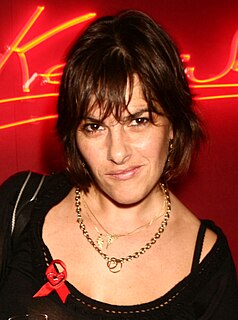
Tracey Karima Emin, CBE, RA is a British artist known for her autobiographical and confessional artwork. Emin produces work in a variety of media including drawing, painting, sculpture, film, photography, neon text and sewn appliqué. Once the "enfant terrible" of the Young British Artists in the 1980s, Tracey Emin is now a Royal Academician.

Sir Antony Mark David Gormley is a British sculptor. His works include the Angel of the North, a public sculpture in Gateshead in the north of England, commissioned in 1994 and erected in February 1998; Another Place on Crosby Beach near Liverpool; and Event Horizon, a multipart site installation which premiered in London in 2007, then subsequently in Madison Square in New York City (2010), São Paulo, Brazil (2012), and Hong Kong (2015–16).
Dorothy Cross is an Irish artist. Working with differing media, including sculpture, photography, video and installation, she represented Ireland at the 1993 Venice Biennale. Central to her work as a whole are themes of sexual and cultural identity, personal history, memory, and the gaps between the conscious and subconscious. In a 2009 speech by the president of UCC, Cross was described as "one of Ireland’s leading artists".
Marc Quinn is a British contemporary visual artist whose work includes sculpture, installation, and painting. Quinn explores "what it is to be human in the world today" through subjects including the body, genetics, identity, environment, and the media. His work has used materials that vary widely, from blood, bread and flowers, to marble and stainless steel. Quinn has been the subject of solo exhibitions at Sir John Soane's Museum, the Tate Gallery, National Portrait Gallery, Fondation Beyeler, Fondazione Prada, and South London Gallery. The artist was a notable member of the Young British Artists movement.

Harlow is a large town and local government district located in the west of Essex, England. Founded as a new town, it is situated on the border with Hertfordshire and London, Harlow occupies a large area of land on the south bank of the upper Stort Valley, which has been made navigable through other towns and features a canal section near its watermill. Old Harlow is a historic village founded by the early medieval age and most of its high street buildings are early Victorian and residential, mostly protected by one of the Conservation Areas in the district. In Old Harlow is a field named Harlowbury, a de-settled monastic area which has the remains of a chapel, a scheduled ancient monument.

The New Art Gallery Walsall is a modern and contemporary art gallery sited in the centre of the West Midlands town of Walsall, England. It was built with £21 million of public funding, including £15.75 million from the UK National Lottery and additional money from the European Regional Development Fund and City Challenge.

Henry Spencer Moore was an English artist. He is best known for his semi-abstract monumental bronze sculptures which are located around the world as public works of art. As well as sculpture, Moore produced many drawings, including a series depicting Londoners sheltering from the Blitz during the Second World War, along with other graphic works on paper.

Art on the Underground, previously called Platform for Art, is Transport for London's (TfL) contemporary public art programme. It commissions permanent and temporary artworks for London Underground, as well as commissioning artists to create covers for the Tube map, one of the largest public art commissions in the UK.

Waikato Museum is a regional museum located in Hamilton, New Zealand. The museum manages ArtsPost, a shop and gallery space for New Zealand art and design. Both are managed by the Hamilton City Council. Outside the museum is The Tongue of The Dog, a sculpture by Michael Parekowhai that has helped to increase visitor numbers. The sculpture was commissioned by MESH Sculpture Trust, Hamilton.
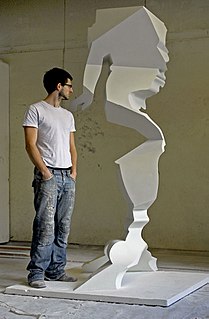
Nick Hornby is a British artist. He received his education at the Slade School of Art, University College London and Chelsea School of Art, a constituent college of the University of the Arts London. Hornby's work is known for his art-historical references and use of digital technology.

Dream is a 2009 sculpture and a piece of public art by Jaume Plensa in Sutton, St Helens, Merseyside. Costing approximately £1.8m, it was funded through The Big Art Project in coordination with the Arts Council England, The Art Fund and Channel 4.

Towner Art Gallery is located in Eastbourne, East Sussex, on the south coast of England.
Therman Statom is an American Studio Glass artist whose primary medium is sheet glass. He cuts, paints, and assembles the glass - adding found glass objects along the way – to create three-dimensional sculptures. Many of these works are large in scale. Statom is known for his site-specific installations in which his glass structures dwarf the visitor. Sound and projected digital imagery are also features of the environmental works.
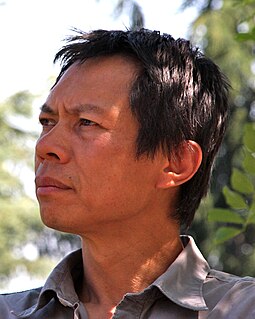
Vong Phaophanit and Claire Oboussier are artists based in London who have collaborated for the past 25 years. Their studio encompasses a wide variety of media including films, books, large-scale installations and photographic and sculptural works. They have created a number of major public commissions.
Ryan Gander OBE RA is a British artist. Gander is a wheelchair user who does not identify as being disabled. He explains: "I don't even feel disabled. I've spent my whole life trying not to be disabled, so I don't want to be labelled a "disabled artist." Since 2003, Gander has produced a body of artworks in different forms, ranging from sculpture, apparel, writing, architecture, painting, typefaces, publications, and performance. Additionally, Gander curates exhibitions, has worked as an educator at art institutions and universities, and has written and presented television programmes on and about contemporary art and culture for the BBC.

Robert Perless is an American artist whose particular focus is kinetic art sculptures.
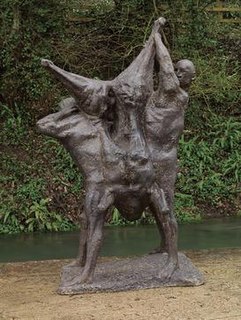
Ralph Brown was an English sculptor who came to national prominence in the late 1950s with his large-scale bronze Meat Porters, commissioned for Harlow New Town, Essex and is known for his sensual, figurative sculptures.
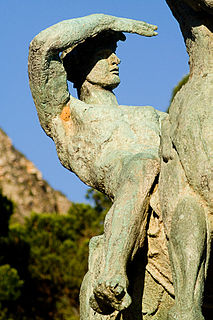
Physical Energy is a bronze equestrian statue by English artist George Frederic Watts. Watts was principally a painter, but also worked on sculptures from the 1870s. Physical Energy was first cast in 1902, two years before his death, and was intended to be Watts's memorial to "unknown worth". Watts said it was a symbol of "that restless physical impulse to seek the still unachieved in the domain of material things". The original plaster maquette is at the Watts Gallery, and there are four full-size bronze casts: one in London, one in Cape Town, one in Harare and one soon to be sited at Watts Gallery - Artists' Village in Compton, Surrey. Other smaller bronze casts were also made after Watts's death.
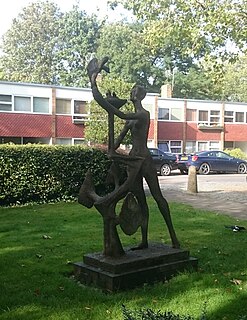
Keith Godwin was an English sculptor.
Harlow Art Trust (HAT) is a registered charity based in Harlow, Essex that was set up in the 1950s to acquire and display sculptures. Having collected many works over the years it now comprises a nationally significant collection located throughout the town. HAT was set up by the lead architect of Harlow New Town Frederick Gibberd. Gibberd wanted the New Town to be a place where people who might not normally have access to art could enjoy great sculptures by great artists on every street corner. Consequently, almost all of Harlow's sculpture collection is in the open air, in shopping centres, housing estates and parks around the town.














